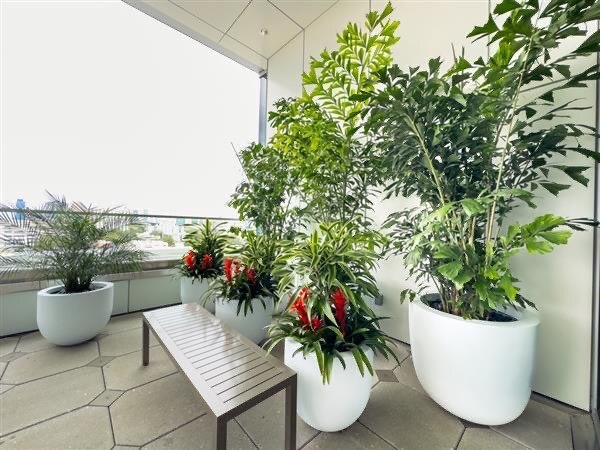Green Wall Systems
& Plant Wall Solutions
Make a statement with a unique plant wall system
The Green Wall Company chosen by many
We offer two types of green wall systems that bring the beauty of nature into your space. Whether you’re looking for a modern office plant wall, a vertical green wall system, or an exterior green wall, our solutions are designed to enhance any commercial environment.
Our Green Wall Options:

Indoor Living Wall System
An Indoor Living Wall System transforms your indoor space by bringing nature inside. These vertical gardens not only serve as striking design elements but also improve air quality, reduce noise, and create a healthier environment. By incorporating living plants on your walls, you enhance the well-being and productivity of occupants. Our customizable green wall systems are low-maintenance and space-efficient, making them perfect for offices, lobbies, or any indoor area where nature can enhance aesthetics and provide biophilic benefits.
%201.png?width=400&height=300&name=Vertical_Ecosystems_1%20(1)%201.png)
Plant Wall Systems
Plant Wall Systems offer a versatile and innovative way to incorporate greenery into both indoor and outdoor spaces. These vertical gardens are designed to maximize limited space while delivering the visual and health benefits of nature. Customizable to fit any environment, plant wall systems enhance air quality, reduce noise, and create a striking, natural aesthetic. Ideal for offices, commercial spaces, or residential properties, these systems are easy to maintain and provide a sustainable solution for integrating plants into your design.

Indoor Moss Wall
An Indoor Moss Wall is a stylish and low-maintenance way to bring nature indoors. Made from preserved moss, these walls create a unique, textured aesthetic that enhances any space while requiring minimal upkeep. Ideal for offices, lobbies, or retail spaces, moss walls provide a calming, natural feel without the need for light or watering. Additionally, moss signage can be integrated into your design, offering a creative and eco-friendly branding solution that leaves a lasting impression on visitors and clients.

Outdoor Green Wall System
An Outdoor Green Wall System elevates the exterior of your building by integrating natural elements into the architectural design. These vertical gardens create a stunning visual impact while also providing insulation, reducing energy costs, and enhancing curb appeal. Perfect for corporate campuses, hotels, and commercial buildings, outdoor green walls are designed to withstand the elements and thrive year-round. They offer a sustainable way to soften hardscapes, promote biodiversity, and create a welcoming, eco-friendly atmosphere for visitors and tenants.

Vertical Green Wall Systems
A Vertical Green Wall System is a space-saving solution that brings nature to any environment, both indoors and out. These vertical gardens enhance the aesthetic appeal of your space while providing functional benefits like improved air quality, noise reduction, and natural insulation. Designed to grow upward, vertical green walls maximize available space and add a modern, eco-friendly touch. Ideal for corporate buildings, retail spaces, and hospitality environments, they create a vibrant, living backdrop that supports sustainability and well-being.
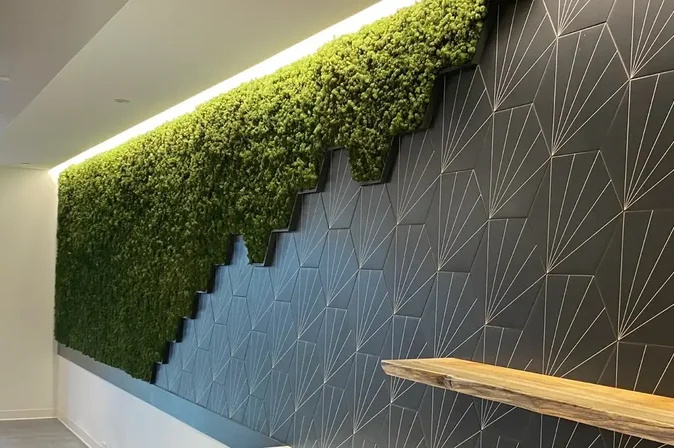
Preserved Moss Wall
Installations can be placed just about anywhere—from the main focal point of your lobby to the restrooms and even the ceiling!
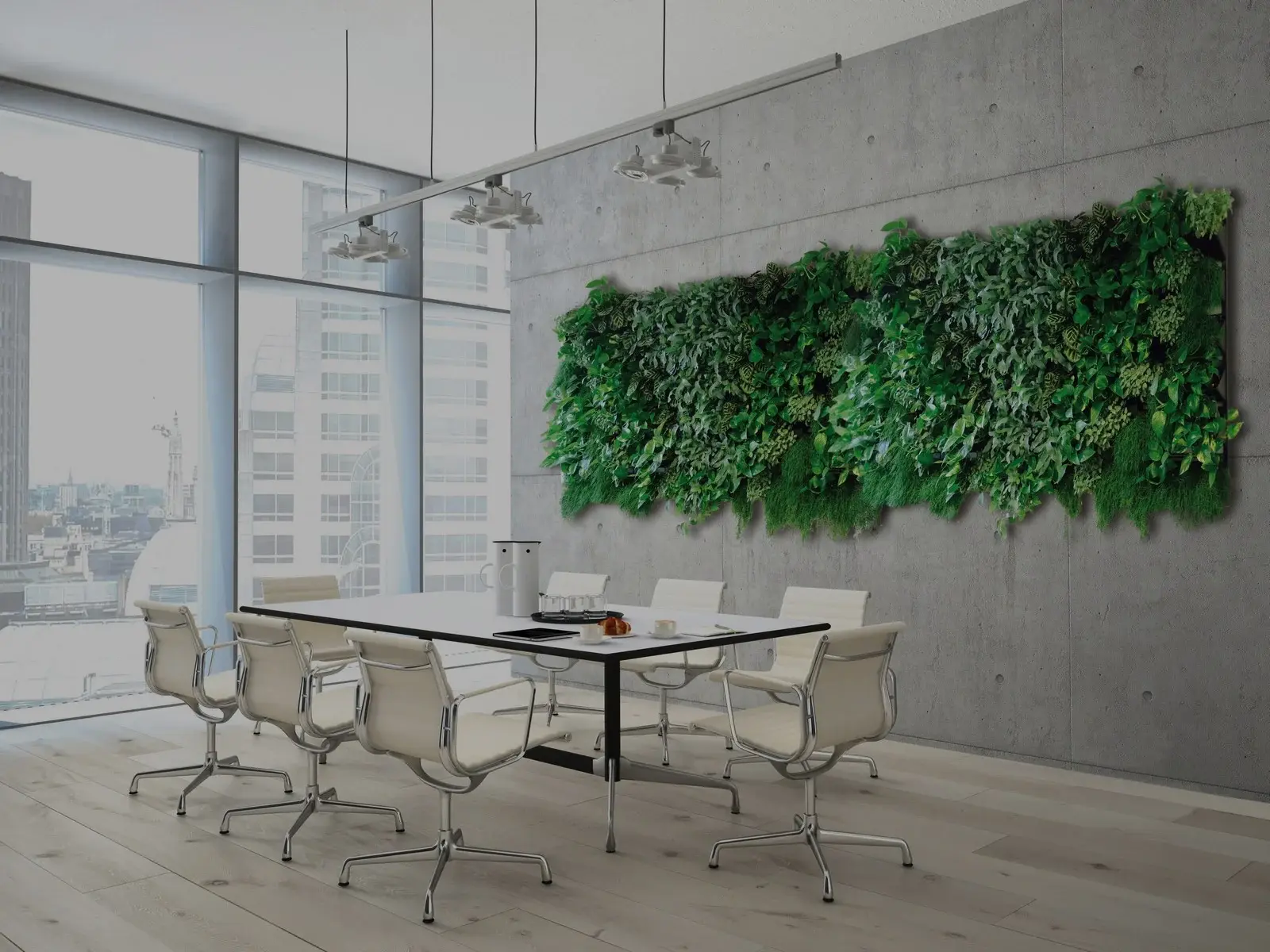
Office Plant Wall
An Office Plant Wall brings the natural world into your workspace, enhancing both aesthetics and productivity. These vertical plant installations make a bold statement while improving air quality, reducing stress, and boosting employee morale. Designed to fit seamlessly into any office environment, plant walls can be customized to reflect your brand's identity and transform sterile office spaces into inviting, energizing areas. With low-maintenance options available, office plant walls create a healthier, more inspiring workplace for teams to thrive.
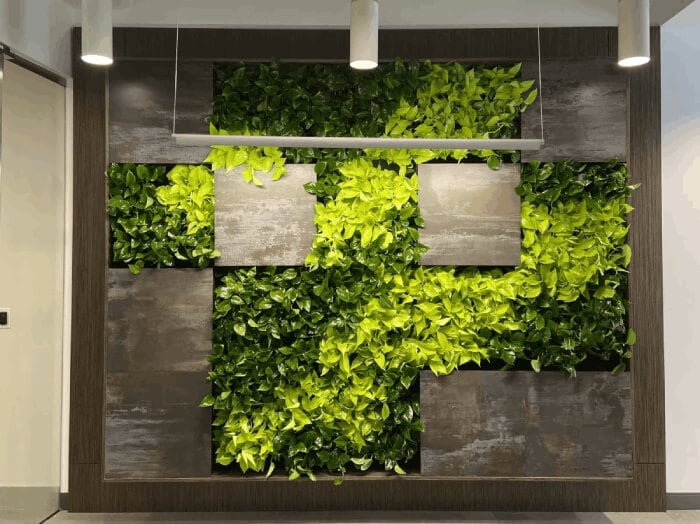
Green Wall for Office
A Green Wall for Office creates a dynamic and refreshing environment by incorporating natural elements into the workspace. These living walls improve air quality, reduce stress, and enhance employee focus and productivity. Perfect for reception areas, meeting rooms, or open office spaces, green walls bring the outdoors in, boosting overall morale and well-being. Customizable to fit any office design, these low-maintenance systems provide an eco-friendly solution that not only beautifies the space but also promotes a healthier work environment.
We offer two primary types of plant wall systems
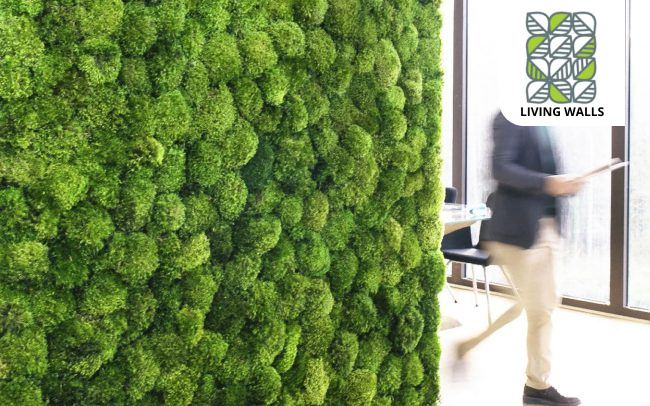
Indoor Vertical Living Walls
With horizontal space at a premium, we have taken plants up the walls to bring the incredible benefits of nature to any commercial environment. Green living walls showcase the impressive diversity of nature and are available in all shapes and sizes, for indoors or out, modular or made to measure.
Impactful & Dramatic Aesthetic
Improved Air Quality
Improve Well-being
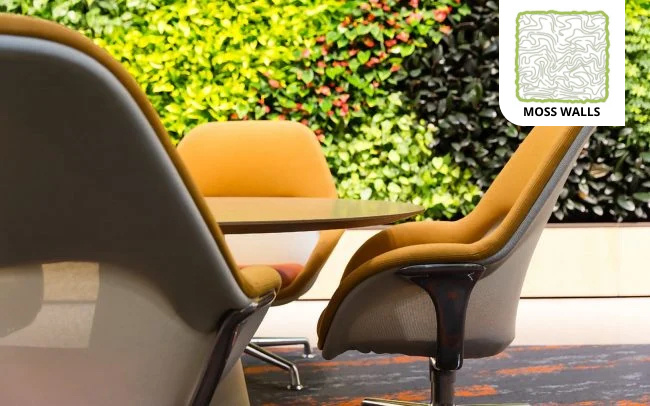
Preserved Moss Wall Art
Our preserved moss wall designs can be placed just about anywhere—from the main focal point of your lobby, to the restrooms, or even the ceiling! Moss Walls do not need on-going maintenance, making them a cost-effective approach to incorporating natural elements into your workplace.
Artistic & Modern Natural Art
Excellent Sound Absorber
Cost Effective Alternative
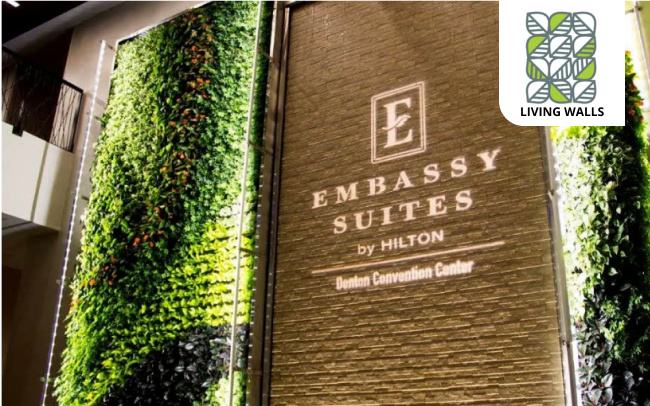
Living walls
Get vertically inspired. Living walls bring a whole new meaning to natural, space-saving interior design. Elevate the aesthetic of any space with a unique and modern approach to live plants. Employees and visitors marvel at the lush greenery and impressively calming displays. Indoors or out, green living walls will massively transform the look and feel of your environment. Get the same benefits of traditional potted live plants, with a unique and unforgettable design feature that will leave a lasting impression.
Explore our product brochure for endless possibilities.
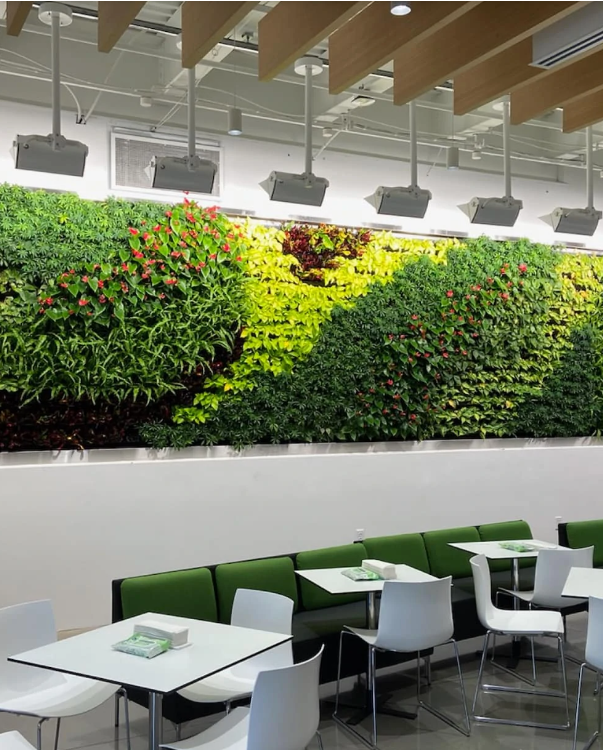
The benefits of living walls
Increased Employee Productivity
Interior plants are more than office decorations. They’ve been scientifically proven to decrease employee stress levels while raising productivity by as much as 12%. Improved workplace morale amongst employees and clients alike has also been linked to indoor live plants. Employee’s productivity, creative performance, and overall satisfaction increase substantially when living foliage and flowering plants are introduced into the work environment. In fact, the majority of Fortune 500 companies have landscaped their office interiors with live plants in order to help boost morale, build employee satisfaction, and promote productivity.
Better Air Quality & Humidity
Sick Building Syndrome is a serious and expensive liability when common microorganisms and toxins become concentrated within sealed office buildings. Research confirms that sealed office buildings are often 10 times more polluted than the air outside. But research also shows that plant-filled rooms contain up to 60% fewer airborne molds and bacteria than rooms without plants. Many studies, including those conducted by NASA, have proven plants commonly used in interior foliage design cleanse the air of many harmful pollutants such as formaldehyde, benzene and trichloroethylene. Plants also help keep humidity within a healthy range, and thus reduce upper respiratory complications for some people. As an employer, adding plants to your place of business can reduce expenses incurred from employee sick days. And healthier employees equal happier employees!
Cost & Energy Savings
Studies show the moisture released by plants in office environments creates a humidity level matching the human comfort range of 30% to 60%. When office air humidity falls below this range, materials such as wood can become cracked. When office air humidity exceeds this range, condensation on windows and exterior walls can cause structural damage. By keeping office air humidity levels within the proper comfort range, interior plants can help avoid costly repairs. Also, the proper selection and placement of plant material can lower heating and cooling costs by as much as 20%.
Impactful Impression
Living green walls are impactful and dramatic! Employees and visitors will marvel at the lush greenery and calming displays. Creatively designed vertical gardens provide attractive color, texture and incredibly stunning displays. The emerging living green wall trend requires design inspiration and an in-depth knowledge of plant species that work. With proper selections, the results are spectacular!
Collaborative Spaces & Sound Control
Modern open office design encourages employee interaction and spontaneous conversation, but this often leads to noise and distraction. One way to reduce the amount of noise in buildings is through the use of plants. Living green walls contribute to overall noise reduction by absorbing, refracting, and reflecting sound waves. The result is a more intimate, quiet space that encourages focused energy and creativity.
Sustainability & LEED
Leadership in Energy and Environmental Design (LEED) is a rating system devised by the United States Green Building Council (USGBC) to evaluate the environmental performance of a building and encourage sustainable design. Planted walls can make a building more energy efficient by providing a shield from strong summer sunlight and provide protective insulation during the winter months. This reduces energy consumption and the building’s carbon footprint. Exterior living green walls also provide a habitat for butterflies, ladybugs and small birds within their ecosystem. The use of living green walls can help a building to earn LEED points making it more attractive to occupants and increase the property’s overall value.
Inviting & Welcoming Environment
The advantages of a professionally installed and maintained landscape go beyond “curb appeal” and head straight for the bottom line. A well-designed interiorscape invites and welcomes customers to your place of business. For multi tenant buildings, adding living plants has been linked to producing higher occupancy rates, increased rentals and lower vacancies.
Examples of our work:
How It Works: Our Four-Step Process
At Natura, we make it easy to enjoy the benefits of live plants without the stress:
1. Connect with us
Schedule a simple consultation with our designers and planners to share your goals and budget.
2. Delivery & Setup
Watch your space transform! Our team will deliver and install your live plants according to plan.
3. Professional Care
Don’t worry about watering and maintaining your plants. Our trained technicians will take care of them for you.

4. Our Guarantee
Rest easy knowing your investment is covered. Any plant under our care is guaranteed or we’ll replace it.
Moss walls
Stand out from the crowd.
Moss walls are innovation meets inspiration. Transform any average space into a modern work of art. Conversation starter. Showstopper. Statement piece. Call it what you will! A moss wall in your commercial space will leave a lasting impression on both employees and customers alike. And with little to no maintenance, moss art installations can be placed just about anywhere to enhance your commercial space.
View a Moss Wall Concept to Creation example →

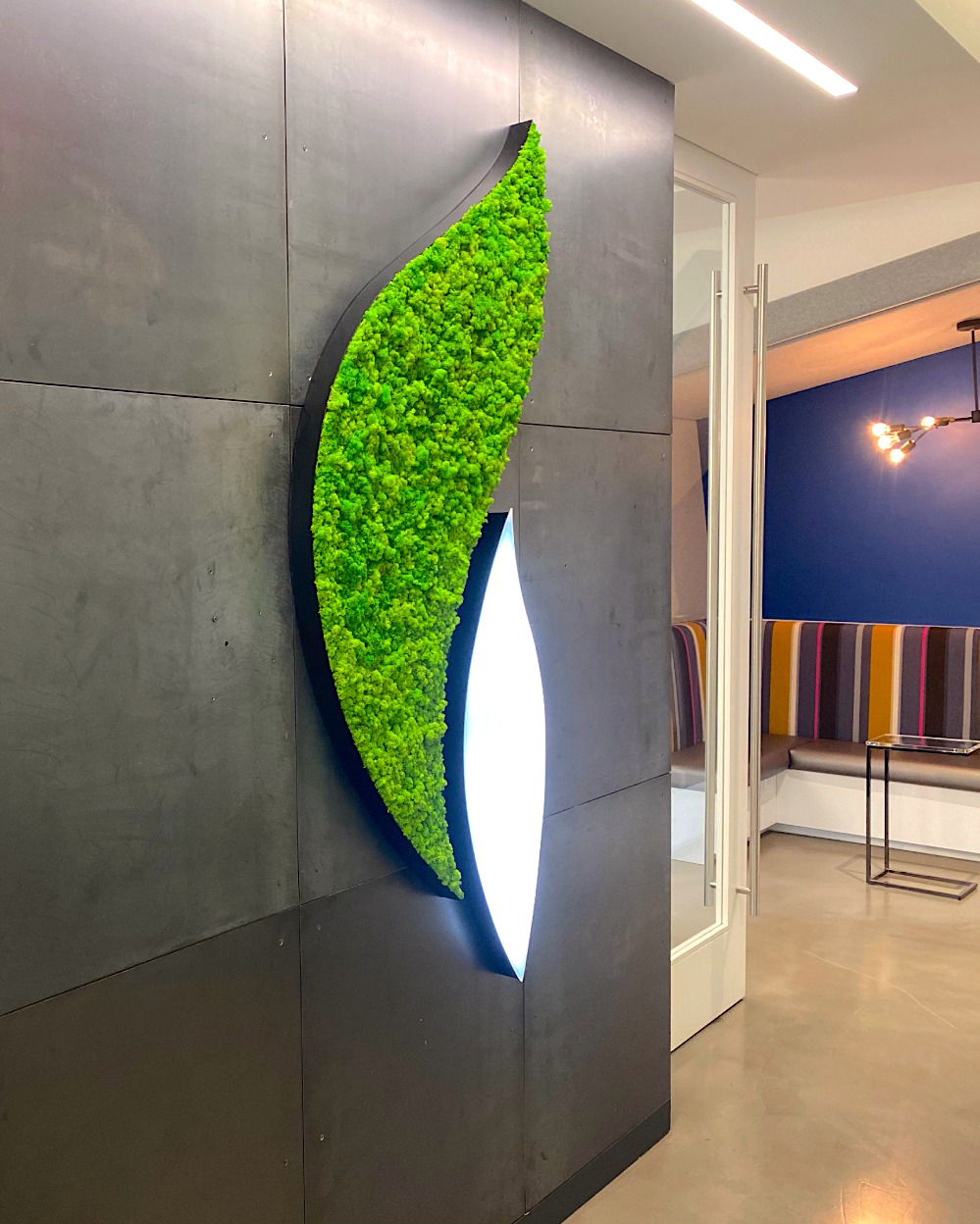
The benefits of moss walls
Natural & Authentic
Only 100% natural and authentic Reindeer, Mood & lichen Moss used
Acoustic Sound Absorber
Absorbing up to twice as much as the industry average for products of same size and thickness
Environmentally Friendly
Our moss is hand-picked with care for nature, certified & approved by ISO 9001 and ISO 14001 standards
Fire Resistant
Our natural preserved moss is cleaned & stabilized for flame retardance certified by ISO 11925-2 for interior use
Air Purifying
Through a constant cycle of absorption and release of ambient moisture, air particles are removed
Natural Humidity Indicator
Reindeer Moss dries when the relative humidity falls below 40%, and returns soft again above 40%
Hypoallergenic
Our products do not contain toxic chemicals or components
Maintenance-free
Preserved Moss does not require any sunlight, watering or pruning
Flexible locations
Preserved Moss installations can be placed just about anywhere—even the ceiling!

The benefits of green walls in commercial spaces
Increased Employee Productivity
Interior plants are more than office decorations. They’ve been scientifically proven to decrease employee stress levels while raising productivity by as much as 12%. Improved workplace morale amongst employees and clients alike has also been linked to indoor live plants. Employee’s productivity, creative performance, and overall satisfaction increase substantially when living foliage and flowering plants are introduced into the work environment. In fact, the majority of Fortune 500 companies have landscaped their office interiors with live plants in order to help boost morale, build employee satisfaction, and promote productivity.
Better Air Quality & Humidity
Sick Building Syndrome is a serious and expensive liability when common microorganisms and toxins become concentrated within sealed office buildings. Research confirms that sealed office buildings are often 10 times more polluted than the air outside. But research also shows that plant-filled rooms contain up to 60% fewer airborne molds and bacteria than rooms without plants. Many studies, including those conducted by NASA, have proven plants commonly used in interior foliage design cleanse the air of many harmful pollutants such as formaldehyde, benzene and trichloroethylene. Plants also help keep humidity within a healthy range, and thus reduce upper respiratory complications for some people. As an employer, adding plants to your place of business can reduce expenses incurred from employee sick days. And healthier employees equal happier employees!
Cost & Energy Savings
Studies show the moisture released by plants in office environments creates a humidity level matching the human comfort range of 30% to 60%. When office air humidity falls below this range, materials such as wood can become cracked. When office air humidity exceeds this range, condensation on windows and exterior walls can cause structural damage. By keeping office air humidity levels within the proper comfort range, interior plants can help avoid costly repairs. Also, the proper selection and placement of plant material can lower heating and cooling costs by as much as 20%.
Impactful Impression
Living green walls are impactful and dramatic! Employees and visitors will marvel at the lush greenery and calming displays. Creatively designed vertical gardens provide attractive color, texture and incredibly stunning displays. The emerging living green wall trend requires design inspiration and an in-depth knowledge of plant species that work. With proper selections, the results are spectacular!
Collaborative Spaces & Sound Control
Modern open office design encourages employee interaction and spontaneous conversation, but this often leads to noise and distraction. One way to reduce the amount of noise in buildings is through the use of plants. Living green walls contribute to overall noise reduction by absorbing, refracting, and reflecting sound waves. The result is a more intimate, quiet space that encourages focused energy and creativity.
Sustainability & LEED
Leadership in Energy and Environmental Design (LEED) is a rating system devised by the United States Green Building Council (USGBC) to evaluate the environmental performance of a building and encourage sustainable design. Planted walls can make a building more energy efficient by providing a shield from strong summer sunlight and provide protective insulation during the winter months. This reduces energy consumption and the building’s carbon footprint. Exterior living green walls also provide a habitat for butterflies, ladybugs and small birds within their ecosystem. The use of living green walls can help a building to earn LEED points making it more attractive to occupants and increase the property’s overall value.
Inviting & Welcoming Environment
The advantages of a professionally installed and maintained landscape go beyond “curb appeal” and head straight for the bottom line. A well-designed interiorscape invites and welcomes customers to your place of business. For multi tenant buildings, adding living plants has been linked to producing higher occupancy rates, increased rentals and lower vacancies.
Professional Green Wall Systems.
Whatever your space or budget, we can help transform the look and feel of any place of business. Our team of designers and trained technicians ensure your plants are strategically selected, installed, and properly maintained. See how we are helping thousands of interior environments go from average to awe-inspiring.
Get Started with Natura
The best Green Wall Company Near You
Ready to transform your space? Contact Natura today to schedule a consultation and explore how our expert indoor plant maintenance services and green wall systems can elevate your business environment. We offer office plant services, vertical green wall systems, and indoor plant care, serving a wide range of industries across multiple locations. Let us bring the beauty of nature to your space with our innovative green wall systems and plant wall solutions.
Areas We Serve:
Green Wall Systems & Plant Wall Solutions: FAQs for Businesses
Q1: What’s the difference between a green wall and a living wall?
A: A green wall is a general term for vertical plant systems, which may include preserved moss, live plants, or modular panels. A living wall specifically features live, growing plants supported by soil or hydroponics, and often includes irrigation and drainage systems.
Q2: Do green walls work in indoor and outdoor environments?
A: Yes! Our systems are designed to thrive both indoors and outdoors. We tailor each installation to your environment, whether it’s an indoor office lobby in Dallas or an exterior feature wall in sunny Orlando.
Q3: How much maintenance do green walls require?
A: Very little. Most systems are designed to be low-maintenance. Our team provides ongoing care, including irrigation checks, pruning, and plant health assessments, so your wall remains lush and vibrant without hassle.
Q4: Can you install green walls in small spaces or multi-tenant buildings?
A: Absolutely. Green wall systems are modular and scalable, making them perfect for compact office walls, narrow hallways, or shared spaces in commercial complexes throughout Texas and Florida.
Q5: What are the benefits of adding a green wall to our business space?
A: Green walls improve air quality, reduce noise, regulate indoor temperatures, and make a bold visual statement that enhances your brand’s image. They’re especially popular in wellness-focused industries and modern office design.
Q6: Do green walls need access to natural light?
A: Not necessarily. While some plant types thrive in sunlight, we also offer systems with integrated grow lighting that allow for placement in lower-light areas like interior hallways or reception desks.
Q7: How long does installation take?
A: Most green wall systems can be installed in 1–2 days, depending on the size and complexity. We provide a clear timeline before starting and installations are coordinated to minimize disruption to your business operations.
Q8: Can we customize the design of our plant wall?
A: Yes! Each green wall is fully customizable—from plant selection and wall layout to company branding and logo integration. We’ll design your wall to align with your space, budget, and aesthetic goals.
Q9: Are green wall systems sustainable?
A: Definitely. Many of our systems use recycled materials, automated irrigation, and low-water plant species, supporting sustainability initiatives and helping businesses work toward green certifications.
Q10: Do you service green walls across Texas and Florida?
A: Yes—we design, install, and maintain green wall systems in all major cities including Houston, Tampa, Austin, Orlando, San Antonio, and more. We’re your local experts in vertical green wall design.

